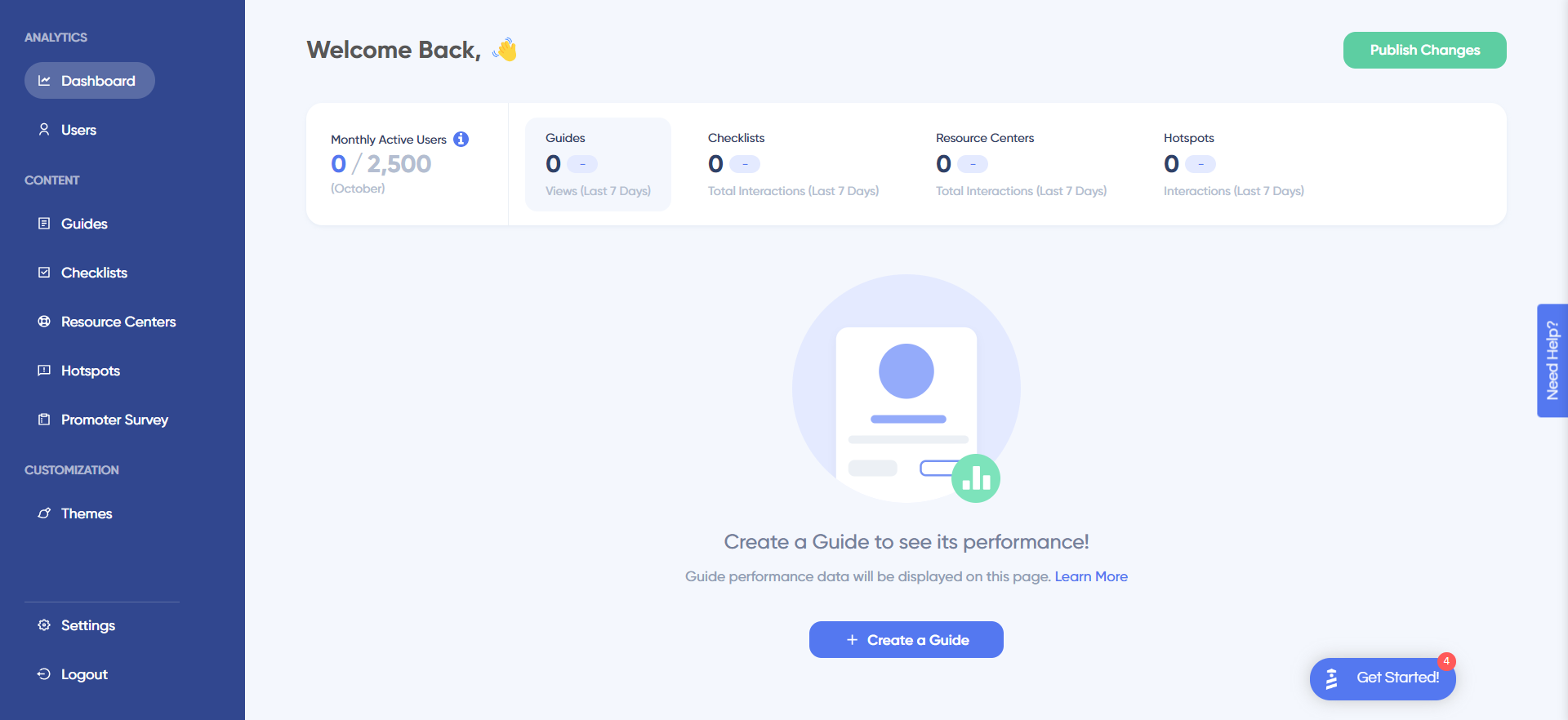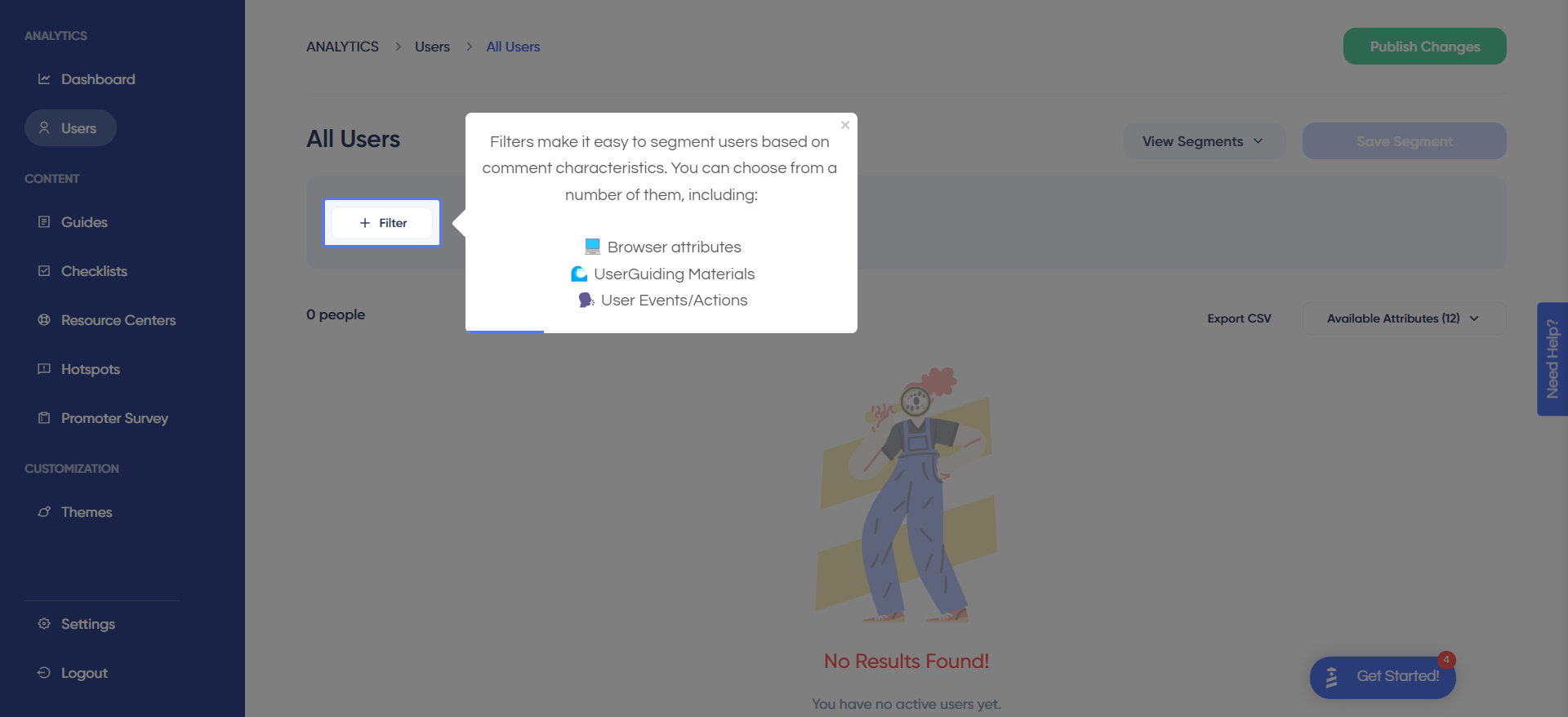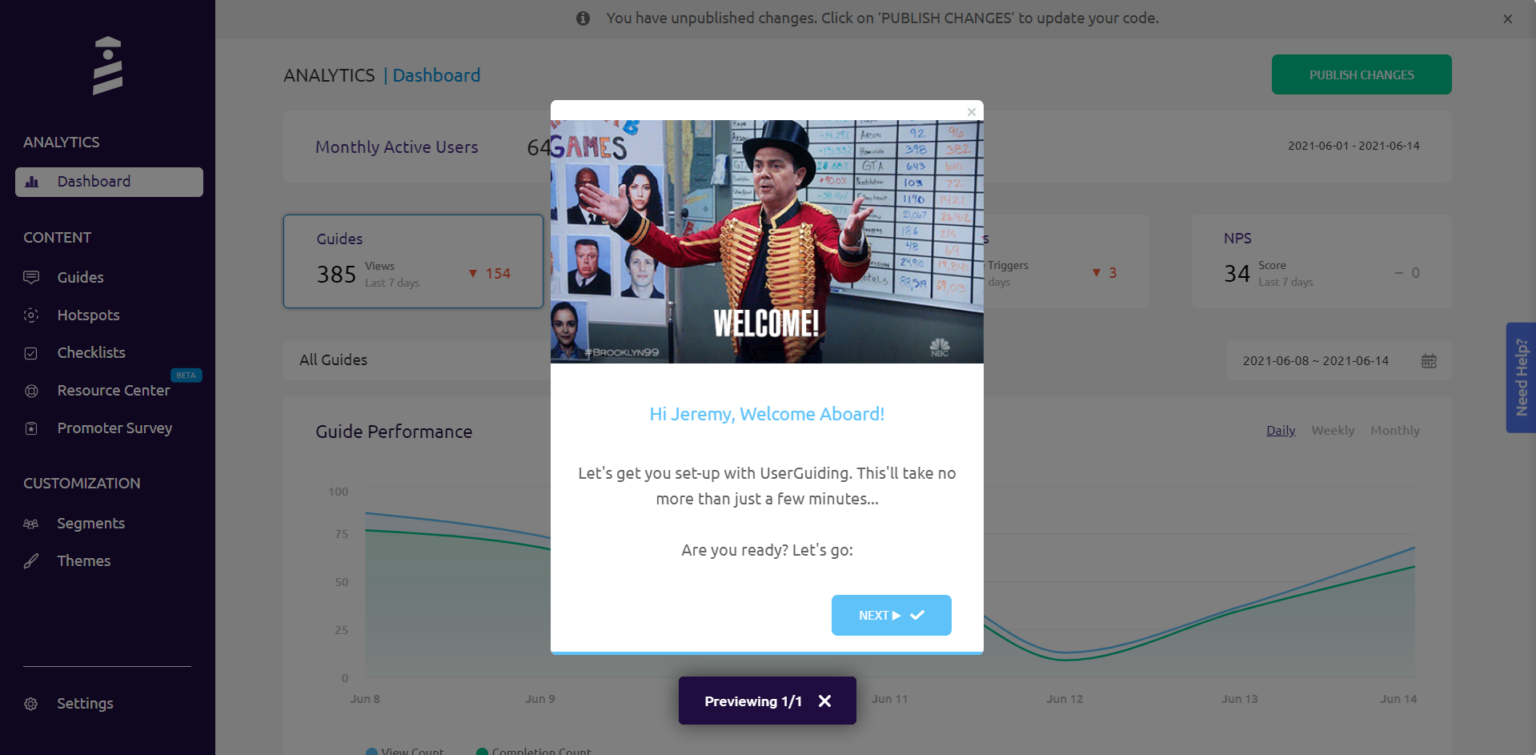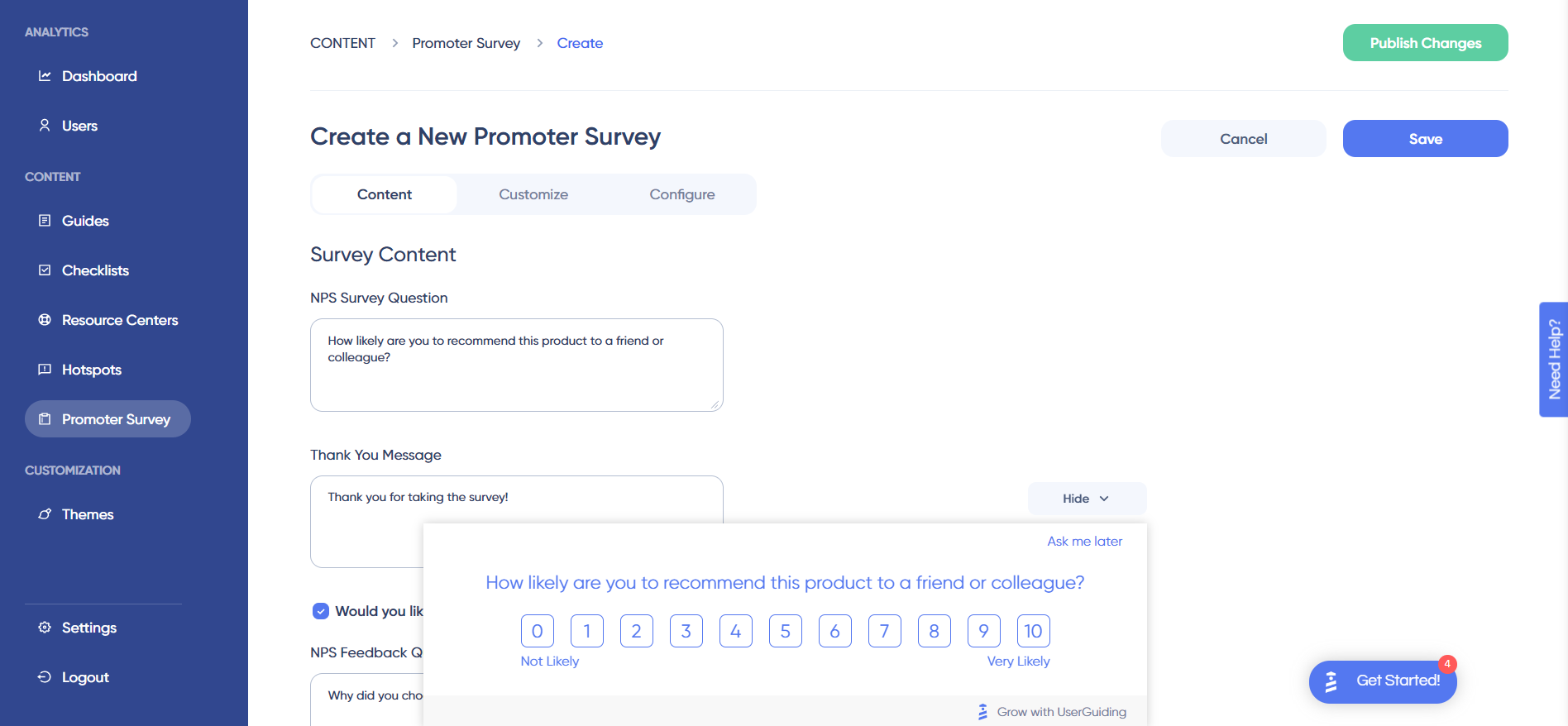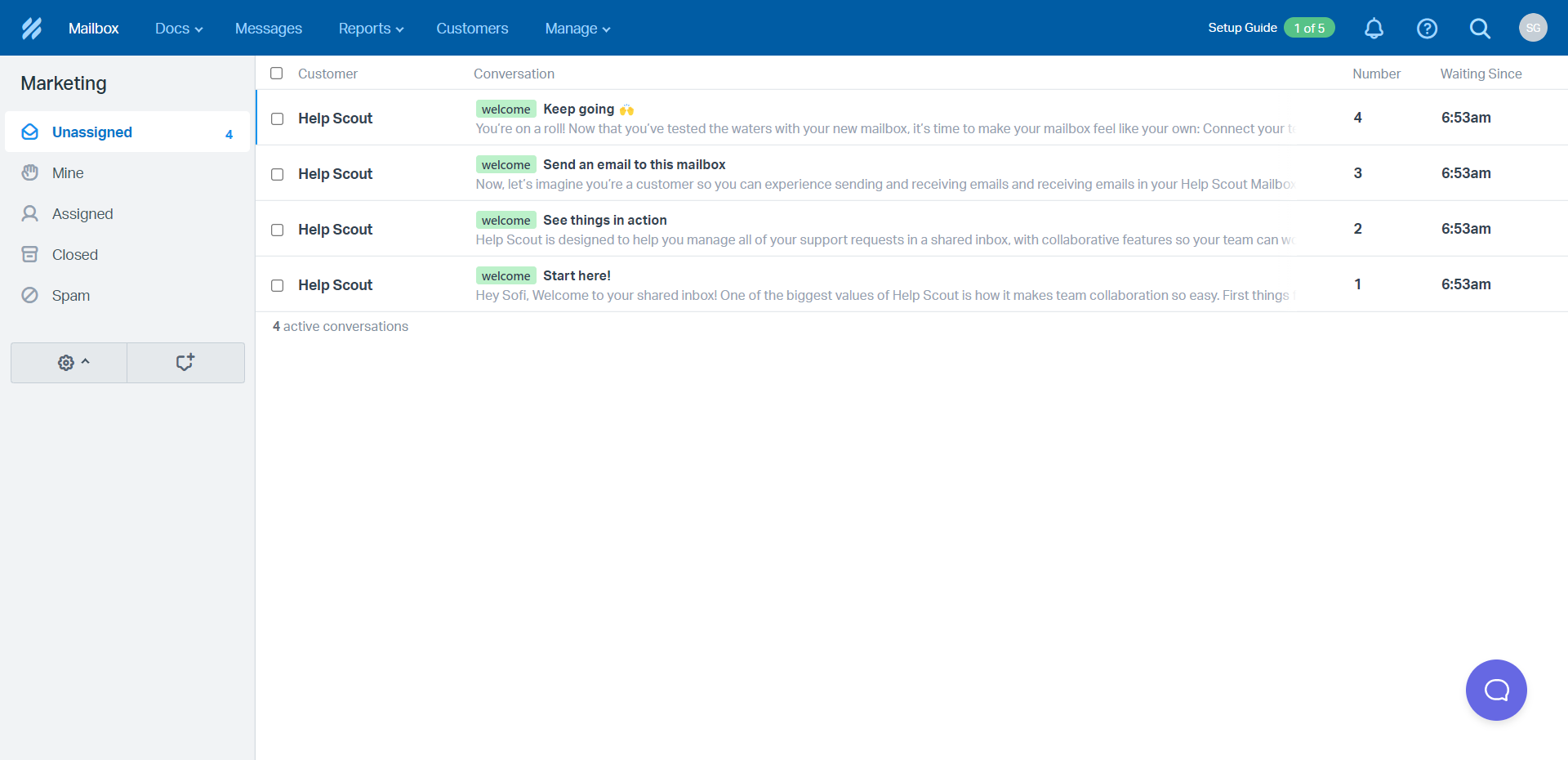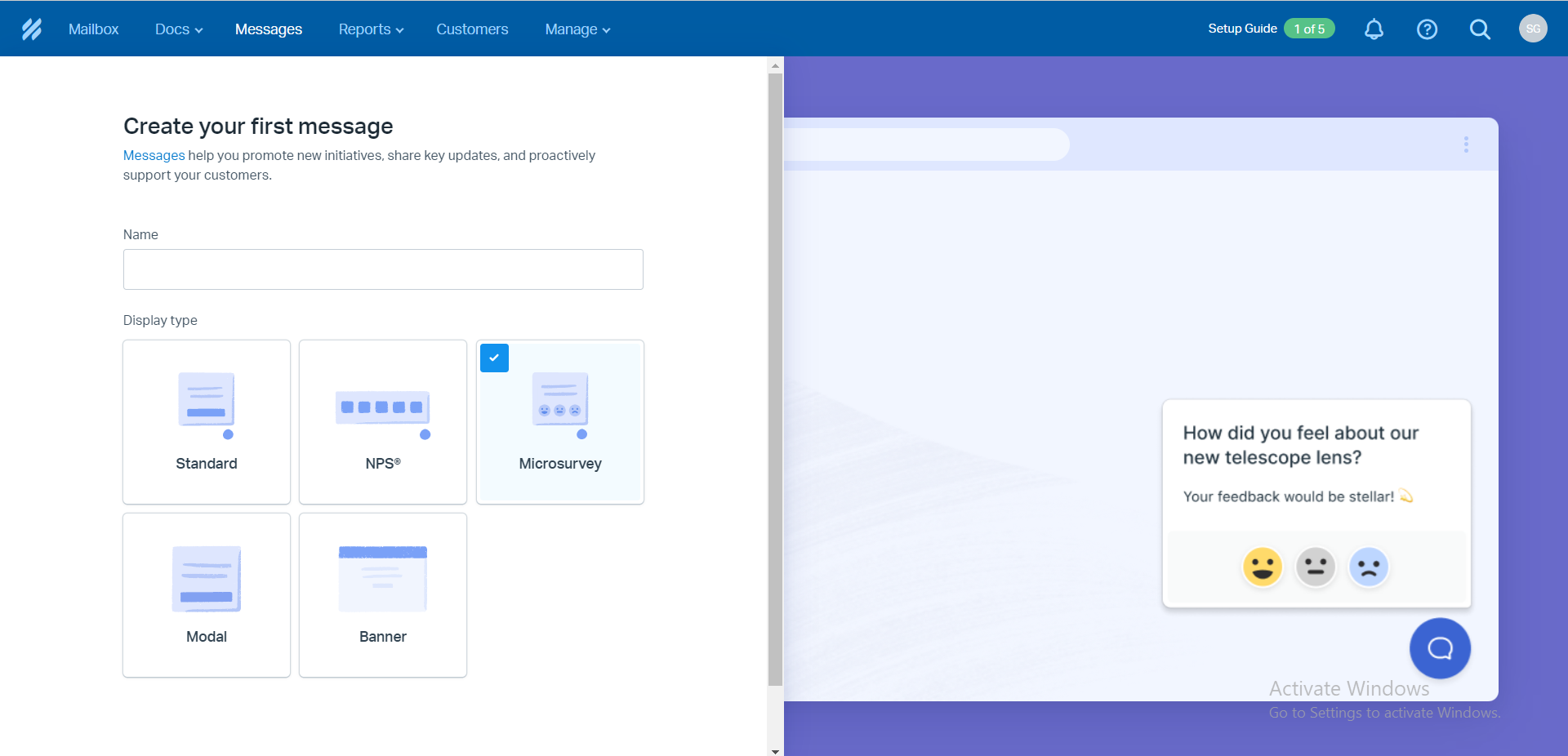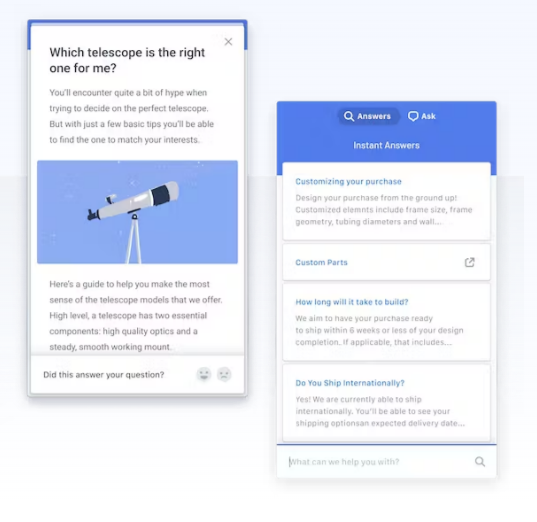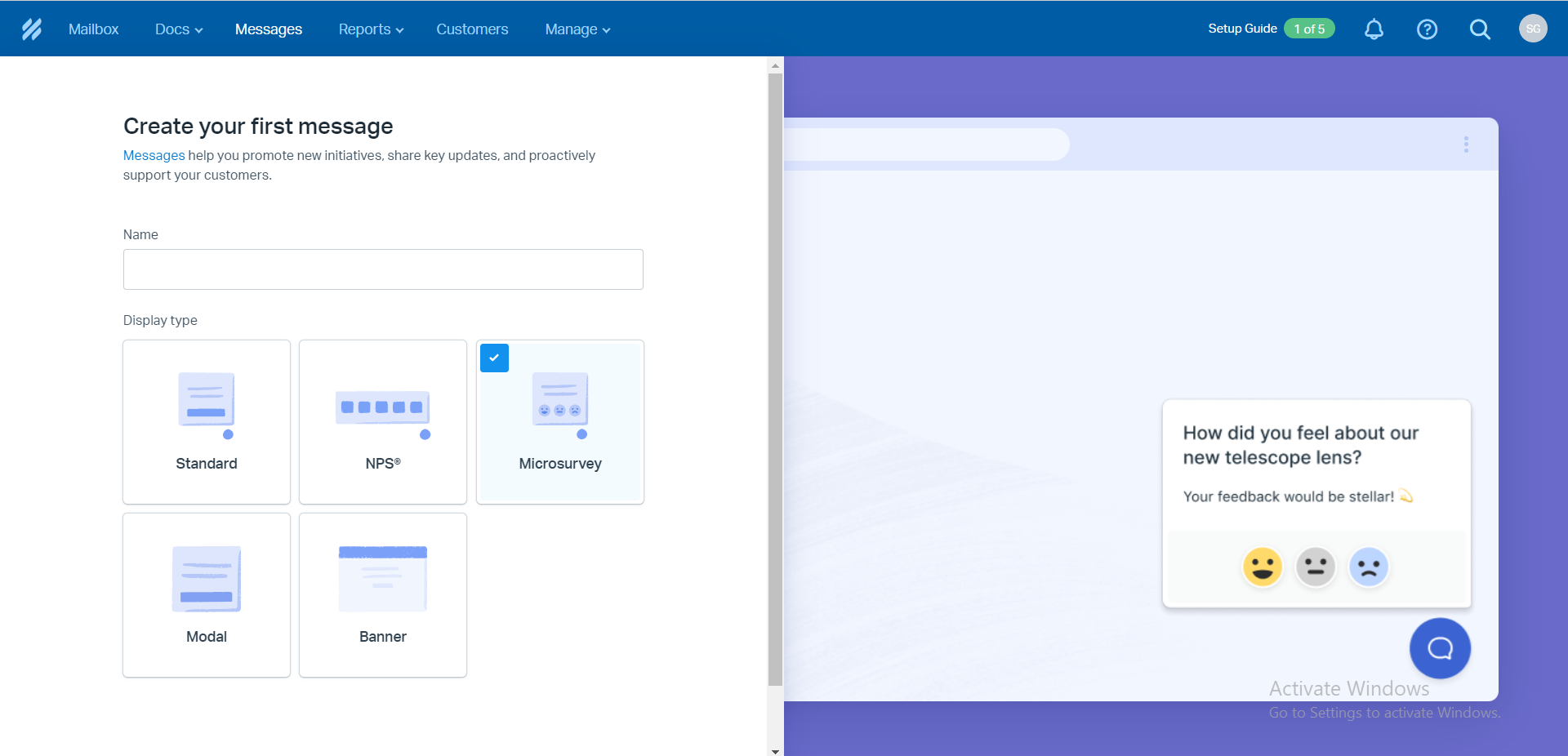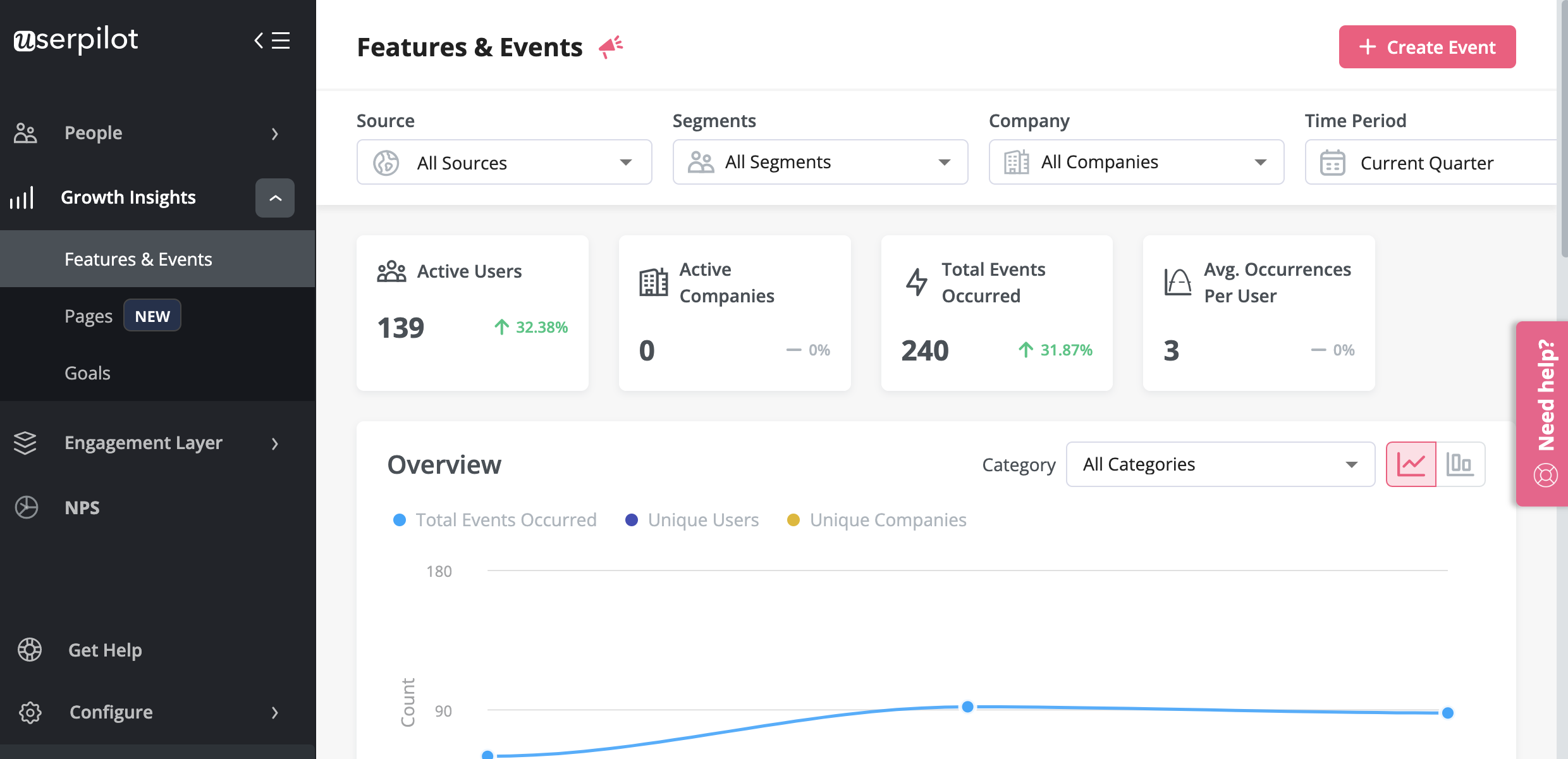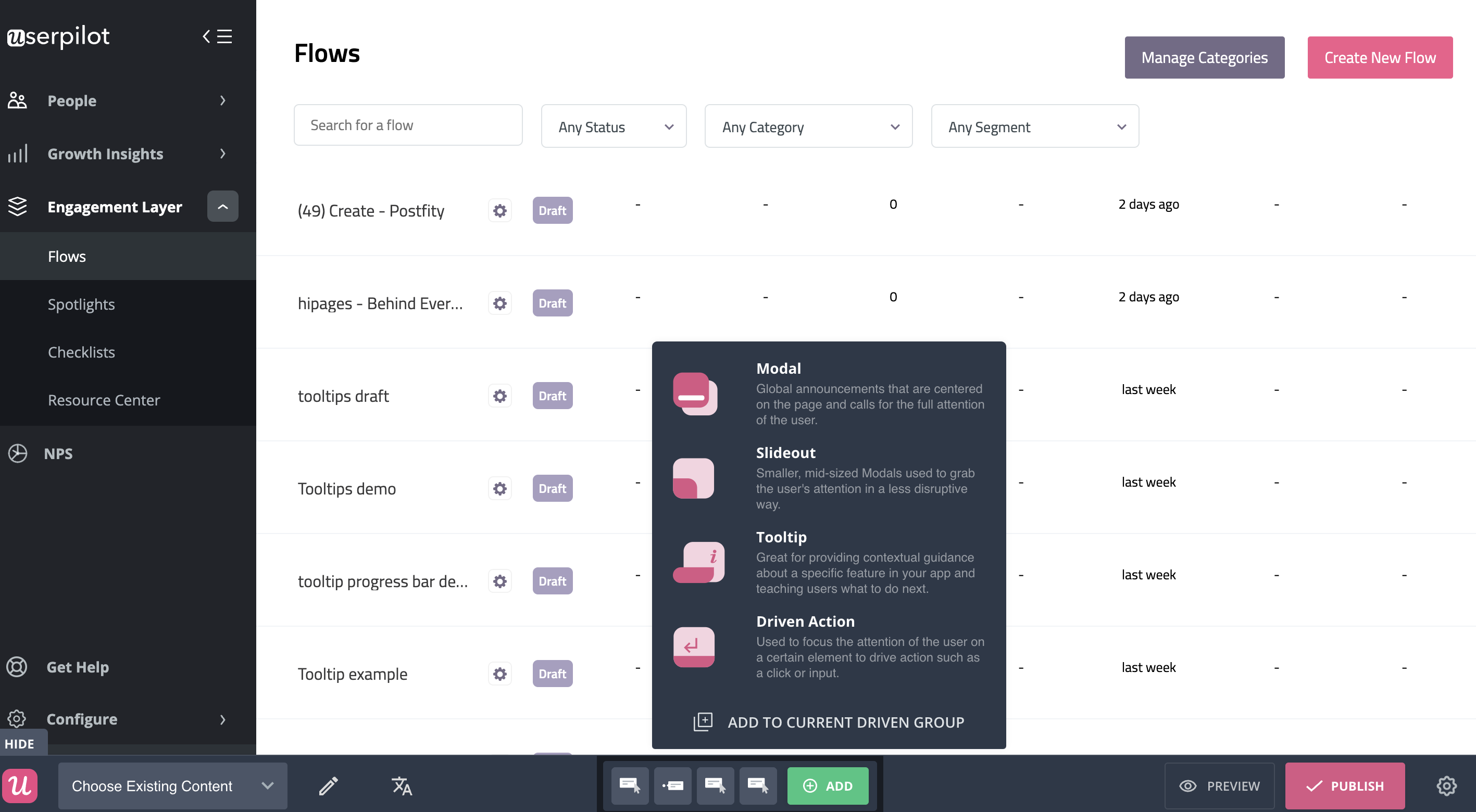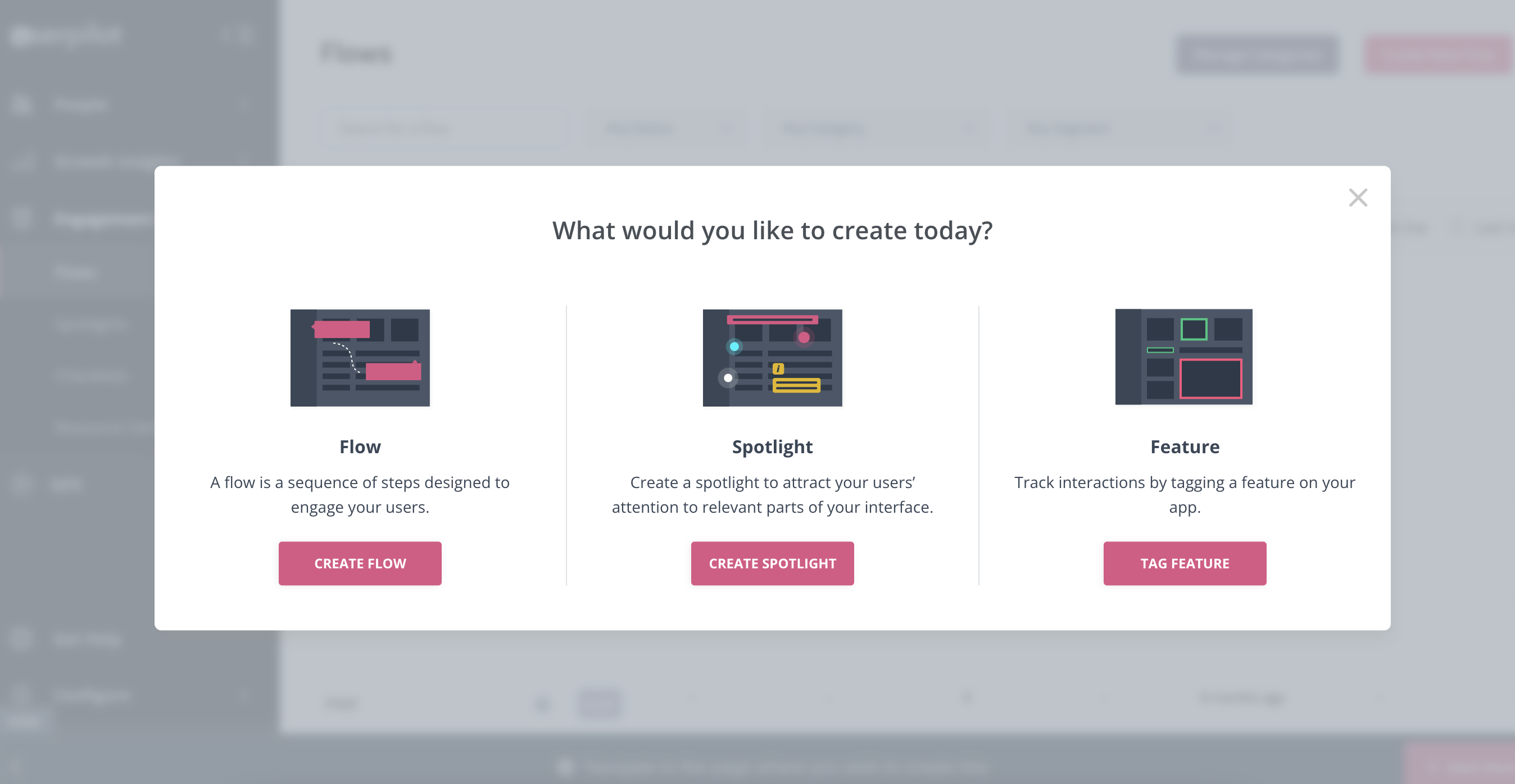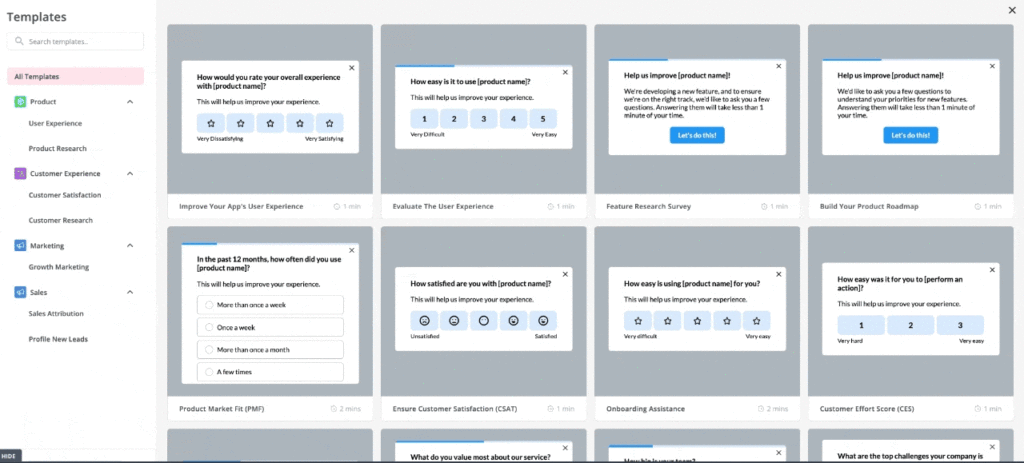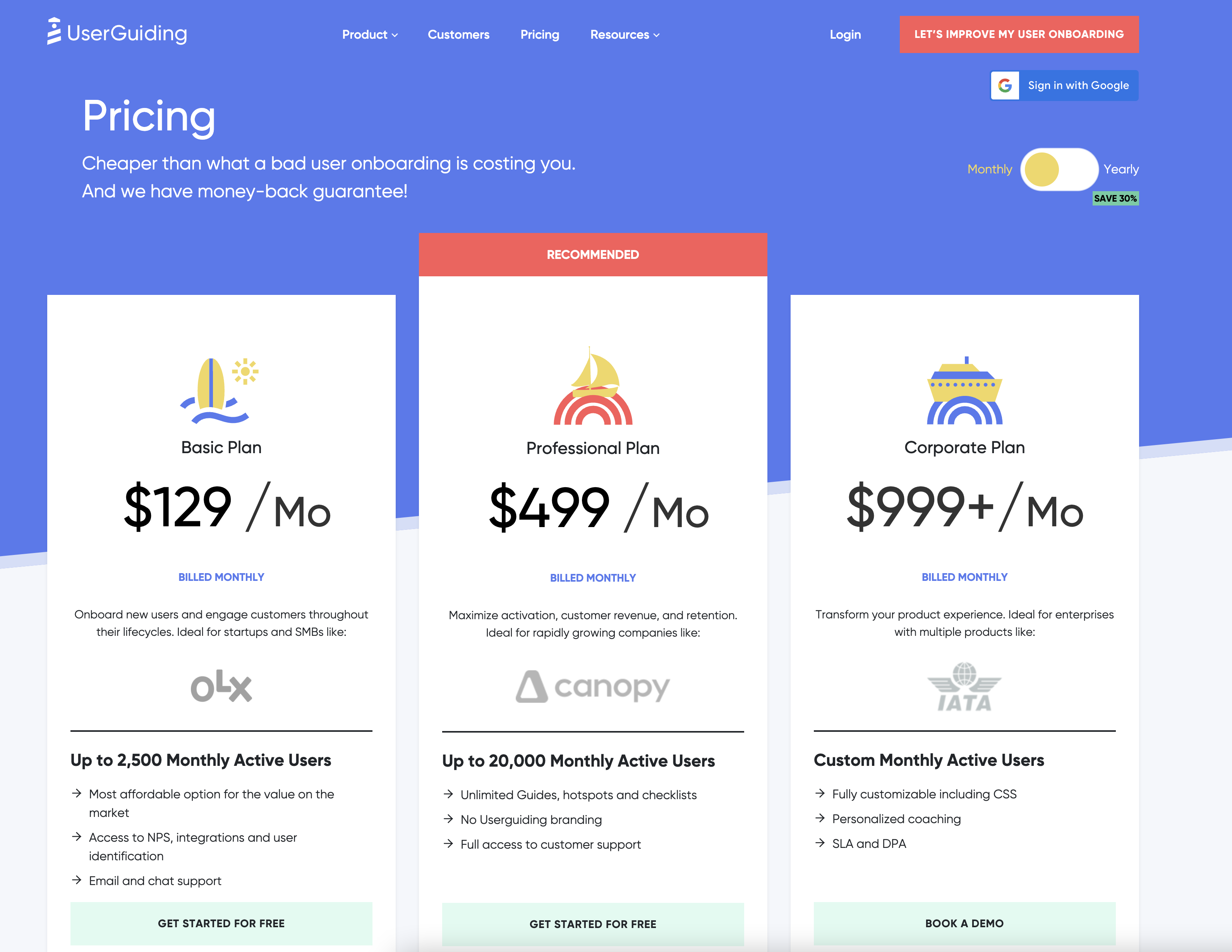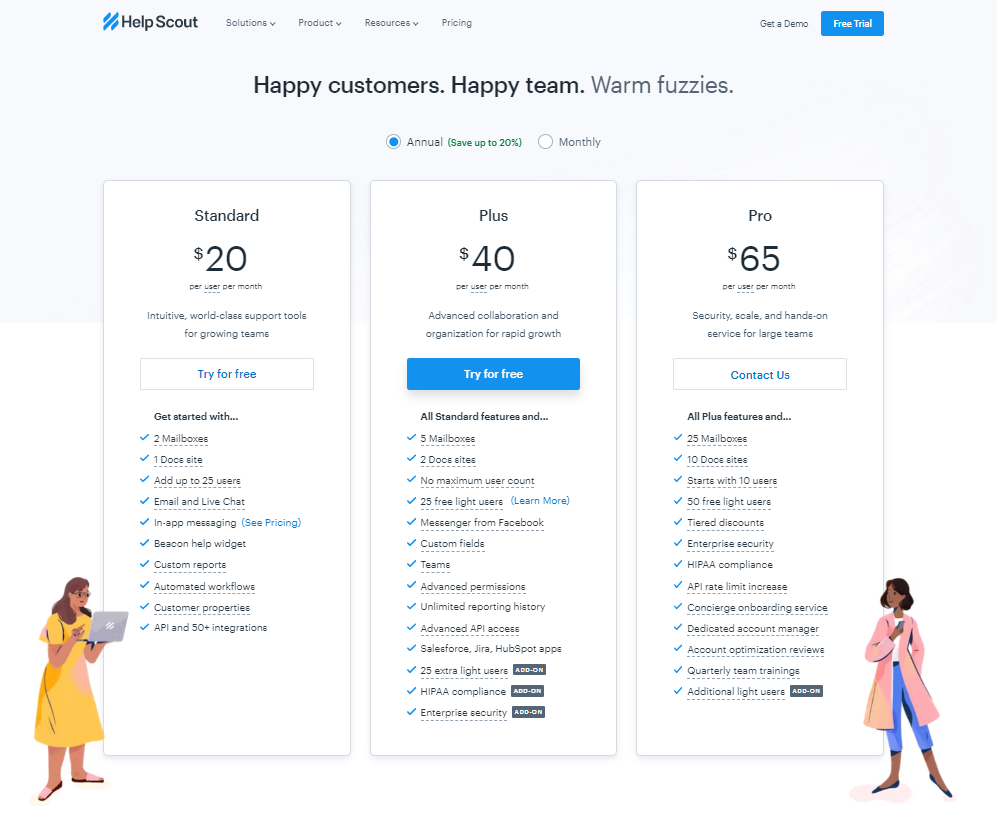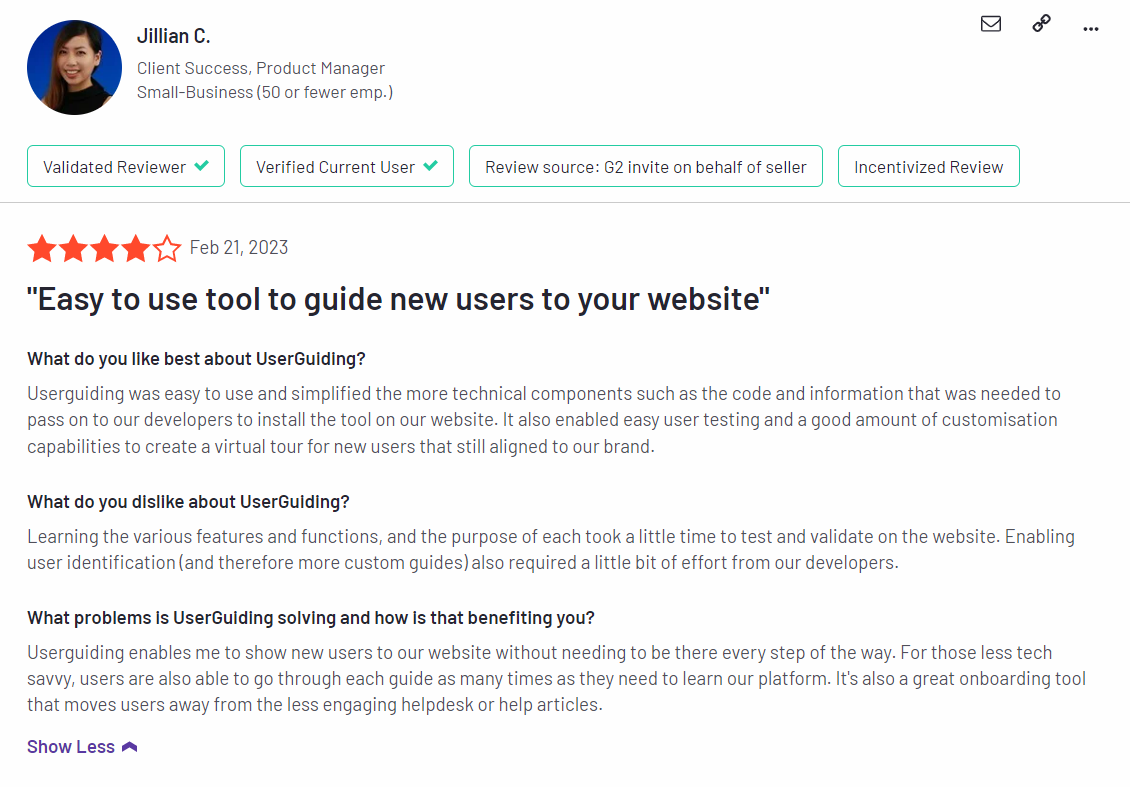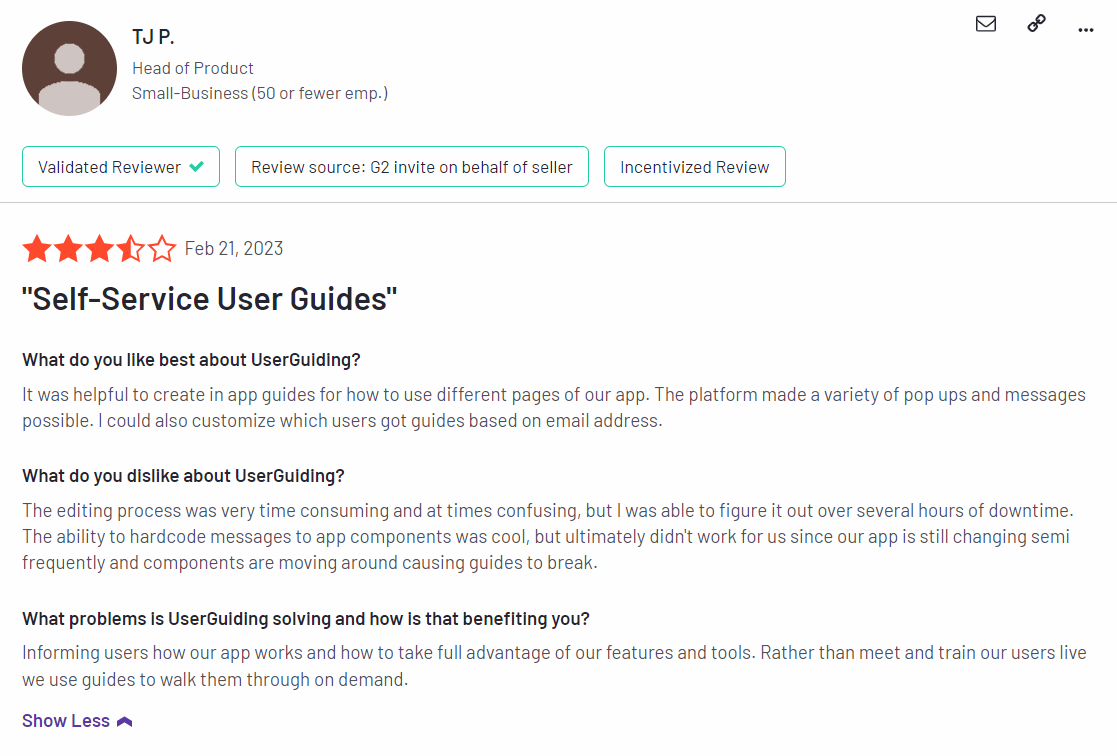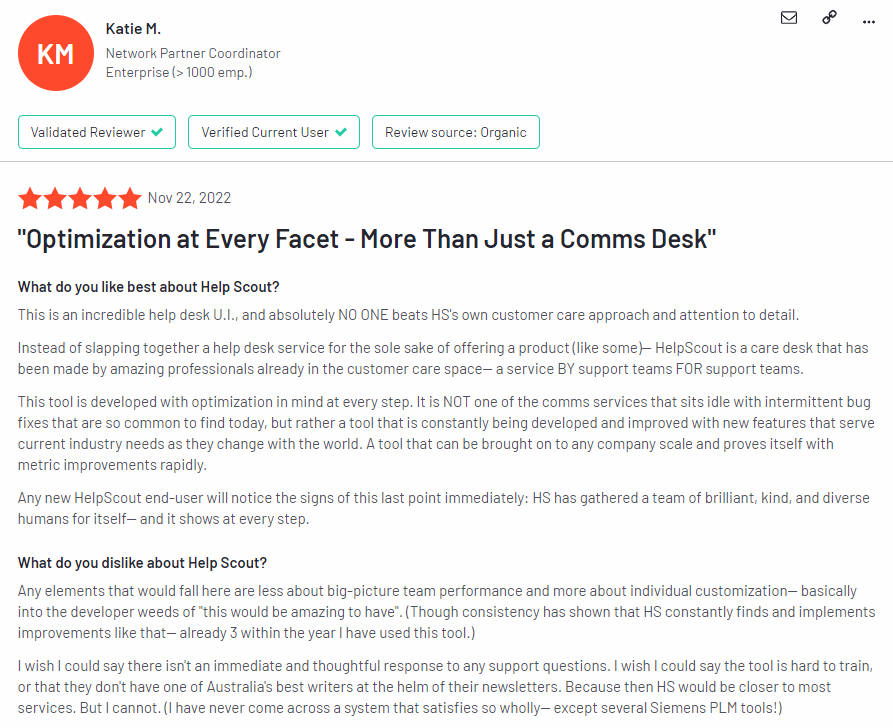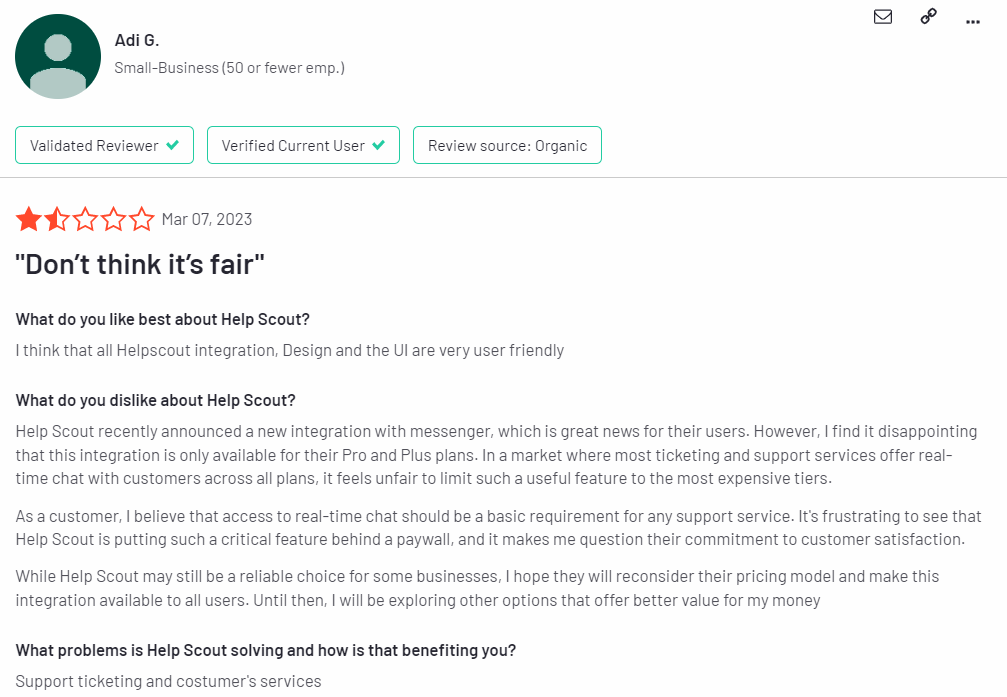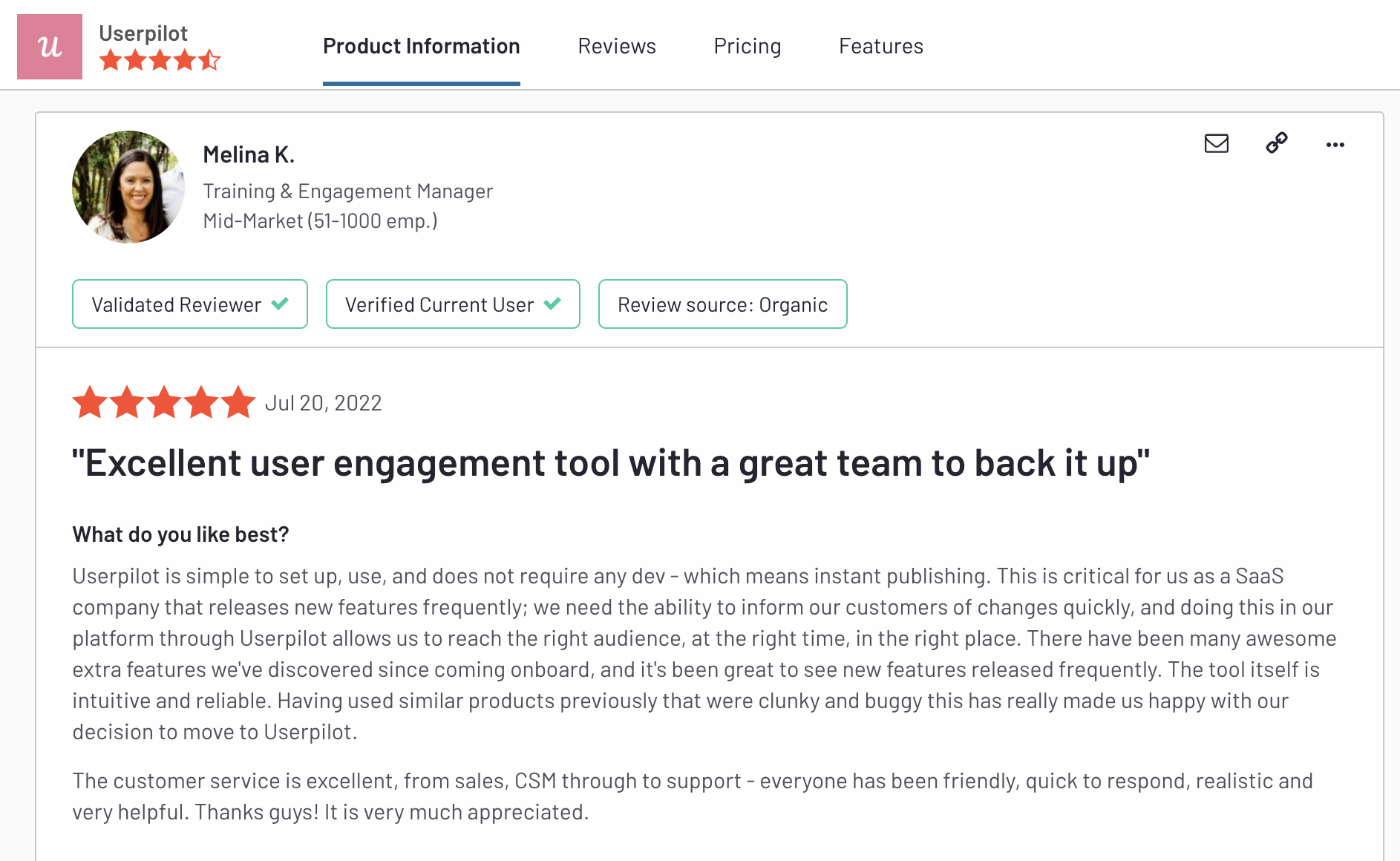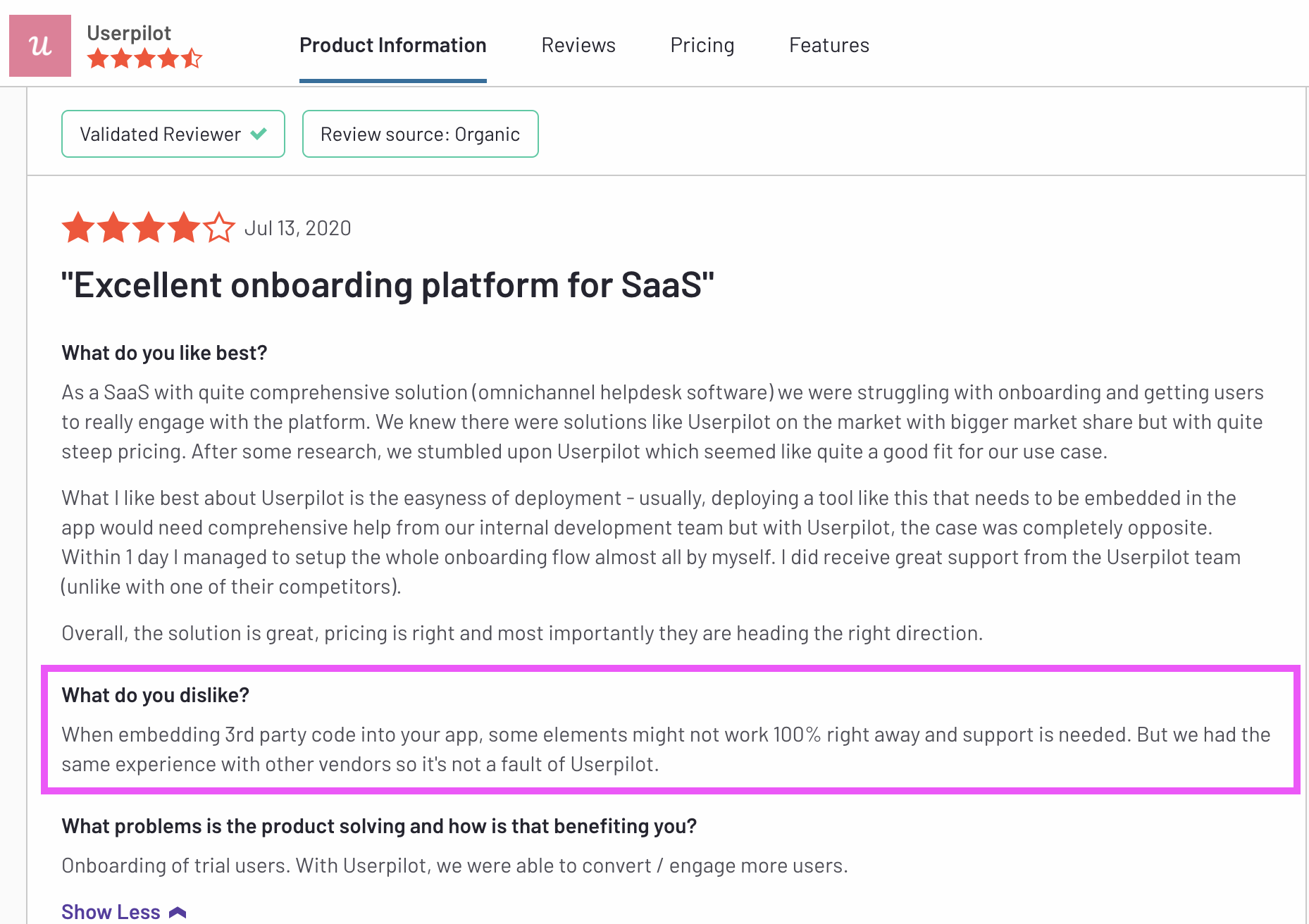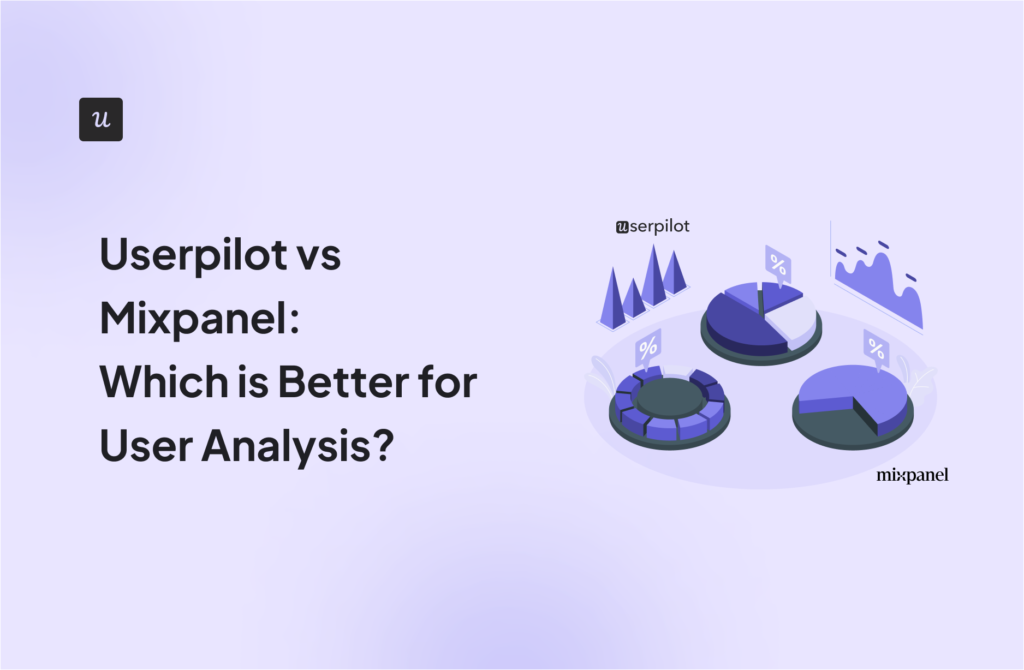
Try Userpilot Now
See Why 1,000+ Teams Choose Userpilot

Userguiding vs HelpScout vs Userpilot: Comparison summary
- UserGuiding is a product adoption tool that helps companies to create interactive user guides and in-app walkthroughs to onboard, engage, and retain their users. It provides a no-code solution that allows non-technical teams to design and implement in-app experiences without any coding skills, but its features are limited. It is however an ok choice is you are just starting out and don’t have a large budget.
- Help Scout is a help desk designed to support businesses in their customer service efforts, offering a variety of tools for customer interactions including a knowledge base, contextual help through beacons, live chat and in-app messaging, and reporting.
- By using Help Scout, businesses can efficiently manage customer interactions and monitor and resolve any issues. However, if you are looking to drive adoption and improve onboarding, you might need an alternative with better functionalities.
- Userpilot is a comprehensive product growth platform. It enables product teams to track product usage and user behavior to guide product development and optimize the user experience. In addition, it allows them to gather user feedback with various survey templates and design personalized onboarding experiences to drive product adoption.
- All of this is possible without coding. Book a Userpilot demo to learn more.
What is Userguiding?
UserGuiding is a product adoption tool that helps companies to create interactive user guides and in-app walkthroughs to onboard, engage, and retain their users. It provides a no-code solution that allows non-technical teams to design and implement in-app experiences without any coding skills.
Overall, UserGuiding is a powerful tool that can help companies to streamline their onboarding process, increase user engagement, and drive customer retention.
What is Userguiding best for?
Typically, SaaS Product Managers consider Userguiding> for the following reasons: they want to improve their user onboarding, they need product adoption, and would also be able to measure their user feedback. How does Userguiding> perform when it comes to these top-three use cases? Let’s examine it all, and then compare to the other tools we’re discussing in this post.
Userguiding for user onboarding
As a no-code onboarding tool, UserGuiding has numerous features that will help you create onboarding flows for your new customers and guide them throughout their journey.
Here’s what you’ll get when you start using UserGuiding:
- Create interactive product walkthroughs without disturbing your developers as it’s completely code-free.
- Build onboarding checklists and drive customers to the activation point by eliminating the guesswork on what the next step should be.
- Create interactive elements, such as product tours, tooltips, and pop-ups, to help keep users engaged and increase the likelihood that they’ll complete the onboarding process.
- Create a resource center to add different educational resources for your users.
Though UserGuiding is a great tool for startups that don’t have much money to invest in an onboarding tool, it has very strict limitations for the Basic plan.
You can only create a maximum of 20 guides and hotspots, 2 onboarding checklists, and 1 resource center. If you want to create unlimited guides with unlimited UI patterns, you should go for the Professional plan which can cost from $299 to $399.
Userguiding for product adoption
UserGuiding helps drive product adoption by providing businesses with a range of tools that help onboard new users, guide them through key features, and drive engagement. Here are some ways in which UserGuiding can help drive product adoption:
- UserGuiding allows businesses to create custom onboarding flows that guide users through the key features of their product. However, the UI elements are quite limited.
- You can gather feedback from users on their onboarding experience with an NPS survey, giving them insights into how to improve the process and drive better adoption rates.
- There is also an option to build an in-app resource center so you can incorporate learning materials in one place and provide on-demand support.
If you’re looking to build complex in-app flows and experiences, UserGuiding is a great fit. However, you don’t get all its features in the Basic plan.
They also don’t have a dedicated customer success manager, and you can’t really customize your flows. Not to mention that it comes with UserGuiding branding which can only be removed if you go for a higher plan ($299).
Userguiding for user feedback
With UserGuiding, you can collect user sentiment data with NPS surveys and micro surveys even when using the Basic plan.
Here’s how you can collect user feedback with UserGuiding:
- Build NPS surveys without writing a single line of code.
- Adjust the thank you page and add a follow-up question to gather qualitative data and understand the reasons behind the scores.
- Customize the button texts, colors, and designs to match your brand.
- Set up custom audiences, segments, timing, and targeting rules to trigger the surveys.
The downside of using UserGuiding for collecting user feedback is that you can’t tag NPS responses to identify trends between scores. You also can’t create long survey forms as they neither support it in their native interface nor have integrations with other 3-rd party tools to do the job.
Considering that, Userpilot undoubtedly offers you more value for money. You can build micro surveys, embed Typeform long surveys, collect and analyze NPS responses, and segment users based on scores and responses so you can trigger more personalized experiences. Get a Userpilot demo here!
There is a better tool for your SaaS than Userguiding!

What is HelpScout?
Help Scout is a help desk designed to support businesses in their customer service efforts, offering a variety of tools for customer interactions.
These tools include a knowledge base, contextual help through beacons, live chat and in-app messaging, and reporting.
By using Help Scout, businesses can efficiently manage customer interactions and monitor and resolve any issues.
If you need to improve your email support, provide Help Center resources for customers, or engage with them through live chat, Help Scout is a great option. It offers pricing plans that are based on the number of users, starting from $20 per user per month when billed annually. However, if you want to drive adoption and improve your onboarding efforts, this tool might not be the best choice for you.
What is HelpScout best for?
Similar to Userguiding, HelpScout is typically considered for user onboarding, product adoption, and user feedback. Let’s examine HelpScout for these use cases before we compare it to Userpilot.
HelpScout for user onboarding
While Help Scout does offer some basic features for user onboarding and adoption, such as knowledge bases and customer communication tools like live chat and basic feedback collection, it is not specifically designed to provide a comprehensive solution for user onboarding.
If your business is primarily focused on user onboarding and adoption, you may need to look for a specialized user onboarding tool like Userpilot or a customer success platform that provides more comprehensive solutions for user onboarding, adoption, and engagement.
HelpScout for product adoption
While Help Scout is primarily focused on customer support and communication, it does offer some features that can support product adoption to a certain extent.
For example, Help Scout’s knowledge base feature can be used to provide self-service support options to customers, which can help them learn more about your product and increase their usage and adoption.
In addition, Help Scout’s customer feedback features, such as customer satisfaction ratings and NPS surveys, can help businesses gain insights into areas where they can improve their product and increase adoption.
However, Help Scout is not specifically designed to provide a comprehensive solution for product adoption. If your business is primarily focused on optimizing product adoption, you may need to look for a specialized tool like Userpilot or a customer success platform that provides more advanced features for user onboarding, adoption, engagement, and retention.
HelpScout for user feedback
Help Scout offers several features that enable businesses to collect and analyze user feedback.
For example, Help Scout’s customer satisfaction survey allows customers to rate the quality of their support experience. Help Scout also offers Net Promoter Score (NPS) surveys, which can help businesses measure customer loyalty and identify areas for improvement.
In addition, Help Scout’s reporting and analytics features allow businesses to track and analyze customer feedback data over time, helping them to identify trends and patterns in customer feedback and make data-driven decisions to improve their products and customer support.
While Help Scout provides some user feedback features, it is not specifically designed to be a comprehensive user feedback tool. Businesses looking for a more specialized in-app user feedback tool may need to look at other options such as Userpilot.
Try a better tool for your SaaS than HelpScout!

What is Userpilot?
Userpilot is a comprehensive digital adoption platform (DAP). It enables product teams to track product usage and user behavior to guide product development and optimize the user experience.
In addition, it allows them to gather user feedback and design personalized onboarding experiences to drive product adoption. All of this is possible without coding.
What is Userpilot best for?
Userpilot is used for similar use cases as HelpScout and Userguiding. Let’s see how Userpilot compares to the tools we discussed before it comes to user onboarding, product adoption, and user feedback.
Userpilot for user onboarding
Userpilot was built specifically for SaaS product teams that want to improve their user onboarding experience and boost user activation.
You can build a huge variety of user onboarding experiences and in-app guidance flows without needing to code.
Here’s what you’ll get when you start using Userpilot:
- Forget about coding in-app experiences: Userpilot is a no-code solution and only requires your dev to install a line of javascript inside your app and for you to download a Chrome extension that opens up the visual builder.
- Build in-app flows using the largest range of UI patterns (modals, slideouts, tooltips, hotspots, banners) and in-app onboarding experiences (checklists, micro surveys, NPS surveys, in-app resource center).
- Get access to a built-in NPS tool for collecting and analyzing user sentiment so you can improve your onboarding process based on real data.
- Create and track combinations of in-app events like clicks, hovers, and form fills, and then analyze all these interactions under your own custom events, which can be built without code or API calls.
- Use advanced product analytics and in-app flows analytics to identify where users need help and create granular user segments to trigger in-app experiences contextually (segment based on user identification data, in-app engagement, custom events, clicks, hovers, form fills, user feedback responses, NPS scores and more).
- Enhance the onboarding experience with in-app help by launching a Resource Center directly inside your app. Add in-app guides, and video tutorials, and give users access to search the knowledge base or reach out to support. Self-service has never been easier.
The best user onboarding is contextual and it happens right where the users need it, inside your app. There isn’t a better user onboarding tool out there that offers more value for the money than Userpilot.
Schedule a demo with our team and get ready to build the best onboarding experiences your users have seen.
Userpilot for product adoption
Product adoption describes the process of getting users to the point where they are experiencing value from your product.
Userpilot is a powerful product adoption platform that enables you to quickly build personalized and contextual in-app experiences targeted to different user experiences – all without writing a line of code.
It’s a great option for enterprise users too since it’s SOC 2 Type II certified and offers robust features for large-scale usage.
Here are some of Userpilot’s product adoption features that you may find helpful:
- A broad range of UI patterns to build fully customizable, contextual, and interactive in-app flows: modals, slideouts, tooltips, hotspots, driven actions, banners, and more. And – most importantly – you are not limited by plan when it comes to how many UI patterns or designs you can build.
- Advanced in-app checklists with built-in gamification elements like progress bars or ”automatically marked complete” tasks: checklists also come with analytics so you can track who is interacting with them and how.
- Fully interactive walkthroughs walk users through engaging and adopting specific features of your app.
- The self-service in-app resource center lets users search your knowledge base directly inside the app, access chat, and support but also launch guides and tutorials when they get stuck.
- User feedback tools allow you to collect insights to improve the product and the user experience, thus leading to a higher product adoption rate. You can also collect NPS data and tag responses to uncover patterns into what makes users stick, or build micro surveys for more granular data. Then you can use all the feedback collected to build user segments based on the answers and personalize the path to higher product adoption for each segment.
Want to see Userpilot in action? Get a demo and improve product adoption with contextual and personalized in-app flows that actually help users.
Userpilot for user feedback
There are two types of feedback you should be focusing on collecting to better understand the health of your product and users.
First, you have user sentiment which looks at user satisfaction and effort scores or loyalty (using NPS surveys). Then you may also want to collect feedback on the functionality of the product or specific features.
You can do all these with Userpilot. In short, you can:
- Collect and track (NPS) in-app with a built-in NPS widget that allows you to fully customize the survey look and feel, and set the trigger frequency and specific targeting.
- Analyze NPS scores, tag responses, and use the data to create specific user segments.
- Build and trigger in-app micro surveys like the classic PMF survey, or similar ones and mix multi-choice and open-ended types of questions to collect specific insights.
- Be in charge of who gets which survey type and when with advanced segmentation capabilities, and of course, you can use the answers to segment your audience.
The advantage of using Userpilot for collecting feedback over other survey tools is that you can better control who sees the surveys but also you can instantly use the data collected to segment your user base and trigger the right experience for them.
For instance, if your users give you a low NPS score because they think you’re missing a critical feature (that you actually have already), you can push an interactive walkthrough guiding them to find and explore this feature.
Tired of bad Digital Adoption tools? Try Userpilot for your SaaS for free!

So Which tool should you choose? Userguiding vs HelpScout vs Userpilot – final thoughts
As you can see, both Userguiding, HelpScout and Userpilot cater to most of the use cases Product Managers typically look for for their SaaS companies. There are some differences between the tools when it comes to how those use cases are executed in each, of course.
So if you’re still on the fence – there are two more factors that can make a difference for you – the tools’ pricing, and its reviews. Let’s have a look at both below!
Userguiding pricing
UserGuiding offers a range of pricing plans to suit different business needs. Here is an overview of their current pricing models:
- Basic plan: For a starting price of $99 per month, or $69 per month with an annual contract, the Basic plan provides access to the essential onboarding tools, but it does have some limitations to keep in mind. These include a maximum of 2500 Monthly Active Users, a single team member, a limit of 20 guides and 2 checklists, as well as UserGuiding branding on all UI patterns.
- Professional plan: With a monthly quota of 20,000 MAUs, the Professional plan offers unlimited guides, hotspots, and checklists. The plan starts at $399 per month or $299 per month with annual billing.
- Corporate plan: With custom MAUs, the Corporate plan provides access to all features as well as personalized coaching. The plan starts at a minimum of $699 per month, or $499 per month with an annual contract.
Additionally, they offer a 14-day free trial for all of their plans, allowing users to try out the product before committing to a paid plan.
HelpScout pricing
Help Scout offers three pricing plans, each with different features and capabilities:
- Standard: The Standard plan is priced at $20 per user per month when billed annually, or $25 per user per month when billed monthly. This plan has some limitations to it such as 2 mailboxes, 1 docs site, and a limit of 25 users. It also comes with in-app messaging with separate pricing if you have more than 2000 unique viewers.
- Plus: The Plus plan is priced at $40 per user per month when billed annually, or $50 per user per month when billed monthly. This plan includes all the features of the Standard plan, plus advanced reporting, automation workflows, and integrations with popular apps like Salesforce and Jira. Add-ons are available
- Company: The Company plan is designed for larger businesses and is billed only annually at $65 per user. This plan includes all the features of the Plus plan, plus personalized onboarding, a dedicated account manager, and enterprise-level security and compliance.
Additionally, Help Scout offers a 15-day free trial, so businesses can test out the platform before committing to a paid plan.
Userpilot pricing
Compared to other tools in the market, Userpilot offers greater value for money as it provides all the necessary tools like engagement, analytics, feedback, and session replays inside one platform. Here’s the detailed Userpilot pricing breakdown:
- The Starter plan is priced at $299 per month (billed annually). It’s designed for small teams or startups with up to 2,000 monthly active users. It includes in-app engagement tools such as walkthroughs, checklists, and banners, along with limited segmentation (up to 10 segments), basic analytics, NPS surveys, and email/live chat support.
- The Growth plan is customized for growing teams needing more advanced product analytics and feedback mechanisms. It includes all Starter features and adds unlimited segmentation and tagging, retroactive event tracking, advanced analytics like funnels and retention, as well as various in-app surveys including PMF, CES, and CSAT. It also enables localized content, content throttling, and access to a self-service Resource Center. Add-ons include session replays and mobile support. This tier comes with a dedicated Customer Success Manager, phone support, and domain customization.
- The Enterprise plan is customized for large organizations with more complex needs. It includes everything in the Growth plan plus additional features such as premium integrations, custom roles and permissions, bulk data management, SAML 2.0 SSO, and activity logs. It also offers priority support with service-level agreements, security audits, and custom billing options. Pricing for this plan is provided upon request.

What do users say about Userguiding vs HelpScout vs Userpilot?
Userguiding reviews
HelpScout reviews
Userpilot reviews
The final countdown: Pros & Cons of Userguiding, HelpScout and Userpilot
Userguiding pros
When it comes to choosing UserGuiding, here are some advantages to consider:
- Easy to use: UserGuiding is a no-code solution, which means it’s easy for non-technical teams to create in-app experiences and user guides without any coding skills.
- Customizable: UserGuiding offers a high level of customization, allowing businesses to create product adoption campaigns that align with their branding and user experience.
- Interactive: UserGuiding’s interactive elements, such as product tours, tooltips, and pop-ups, help keep users engaged and increase the likelihood that they’ll complete the onboarding process.
- Analytics and user feedback: UserGuiding provides simple analytics and Net promoter tool that help businesses measure the success of their onboarding campaigns and make data-driven decisions.
- Integration: UserGuiding integrates with popular analytics and CRM platforms, such as Mixpanel, Hubspot, Woopra, Slack, Webhook, etc.
- Cost-effective: UserGuiding offers a range of pricing plans to suit different business needs, making it an affordable option for small startups or independent businesses.
- Customer support: UserGuiding offers responsive customer support to help businesses get the most out of their product adoption campaigns.
Userguiding cons
Though UserGuiding is a solid product, it has its disadvantages:
- Limited branding options: While UserGuiding offers some branding customization options, the free and lower-priced plans display UserGuiding branding on all UI patterns, which may not align with some businesses’ branding requirements.
- Limited user roles: UserGuiding only offers two user roles – admin and member – which may be limiting for larger organizations that require more granular access controls.
- Limited integrations: Although UserGuiding does offer integrations with popular analytics and CRM platforms, it may not integrate with all of the tools that a business uses, which could lead to additional manual work.
- Learning curve: Although UserGuiding is easy to use, there may still be a learning curve for non-technical teams, especially for those who have never created in-app experiences before.
- Limited customization options: While UserGuiding is highly customizable, it may not offer as much flexibility as other tools in the industry, like Userpilot.
It’s important to keep in mind that these cons may not apply to all users, and some businesses may find that the benefits of UserGuiding far outweigh these limitations.
HelpScout pros
Help Scout’s various tools and features make it easy to provide excellent customer support, while its affordable pricing plans make it accessible to businesses of all sizes. Here are some of the pros of using Help Scout:
- Easy to use and user-friendly interface: Help Scout’s layout and design make it simple to manage and organize customer interactions, which can save you time and reduce confusion.
- Affordable pricing plans, with user-based options: Help Scout offers pricing plans that are based on the number of users, starting from $20 per user per month when billed annually. This makes it a cost-effective option for businesses that need to keep their expenses under control.
- Seamless integrations with popular tools: Help Scout integrates seamlessly with 50+ popular tools. This means businesses can use Help Scout alongside their existing tools and workflows, making it easy to integrate into their existing infrastructure.
HelpScout cons
While Help Scout has many pros, like any software platform, there are also some potential drawbacks to consider. Here are some cons to using Help Scout:
- Lacks the straightforward ticketing feature that most alternatives offer.
- The reporting can be limited to what your needs as a growing company may be. Trying to get the reports emailed and importing information to other services can be a challenge. You may need to use several means of documenting and collecting data for your customers based on what they want to hear about and see the data for.
- Merging tickets can also be a bit confusing as it will sometimes change the profile name but the previous email addresses will remain so when you send, things can go to the wrong party.
Userpilot pros
Userpilot has a number of advantages, especially for mid-market SaaS companies looking for a robust but at the same time very easy-to-use, no-code tool for user onboarding, product adoption, and simplified product analytics. Let’s have a look at the pros of using Userpilot:
- No-code builder – Userpilot comes with an easy-to-use Chrome Extension builder.
- Multiple UI patterns – choose from a range of options to build customized flows: modals, slideouts, banners, tooltips, hotspots, and checklists are all at your disposal
- UI patterns are not limited by plan – you get access to all of them on every single plan, meaning you get value even with the Traction plan (this is the entry-level one).
- Engaging walkthroughs and onboarding flows- build interactive walkthroughs targeted to distinct user segments.
- In-app help – build a resource center offering self-service support to your users, customize it with your branding, and select from a range of help options to boost user satisfaction (i.e. videos, in-app flows, chat, and more).
- Experimentation – built-in A/B testing for flows lets you explore and quickly iterate based on direct user behavior.
- Powerful feedback options- integrated NPS surveys with analytics and response tagging unlock insight into how your users feel.
- Advanced analytics and segmentation- analyze product usage and in-app flow engagement and build user segments using the data.
- Event tracking and feature tags- tag UI engagement (clicks, form fills, hovers) and group them into one custom event to track what really matters.
- More value with integrations- unlock value faster with built-in integrations with popular tools like Segment, Amplitude, Mixpanel, Kissmetrics, Intercom, Heap, and more.
Userpilot cons
There are, however, some downsides to Userpilot as well:
- Browser/web app only – Userpilot won’t run on mobile devices/applications.
- Doesn’t support employee onboarding- The tool is better suited for customer onboarding than for employee onboarding as you can’t build in-app guides on third-party tools.
- Missing integrations – doesn’t have built-in integrations with some tools, but it has webhooks, and Hubspot and Zapier are coming soon.
- Not appropriate for small startups on a shoestring budget (<$100)- Userpilot is a powerful, mid-market to enterprise-level tool. So $299 a month might be too expensive for really small startups.
Try the best tool for user onboarding for FREE!

Conclusion
In this post, we’ve discussed how Spekit, ProductFruits, and Userpilot compare when it comes to user onboarding, product adoption, and user feedback.
We’ve discussed their features for each use case, pricing, and reviews, as well as the pros and cons. Hopefully, you’ve found these detailed descriptions helpful. Obviously, we’re a little biased, but we think that Userpilot offers the best value for money, and is unrivaled especially when it comes to user onboarding.

